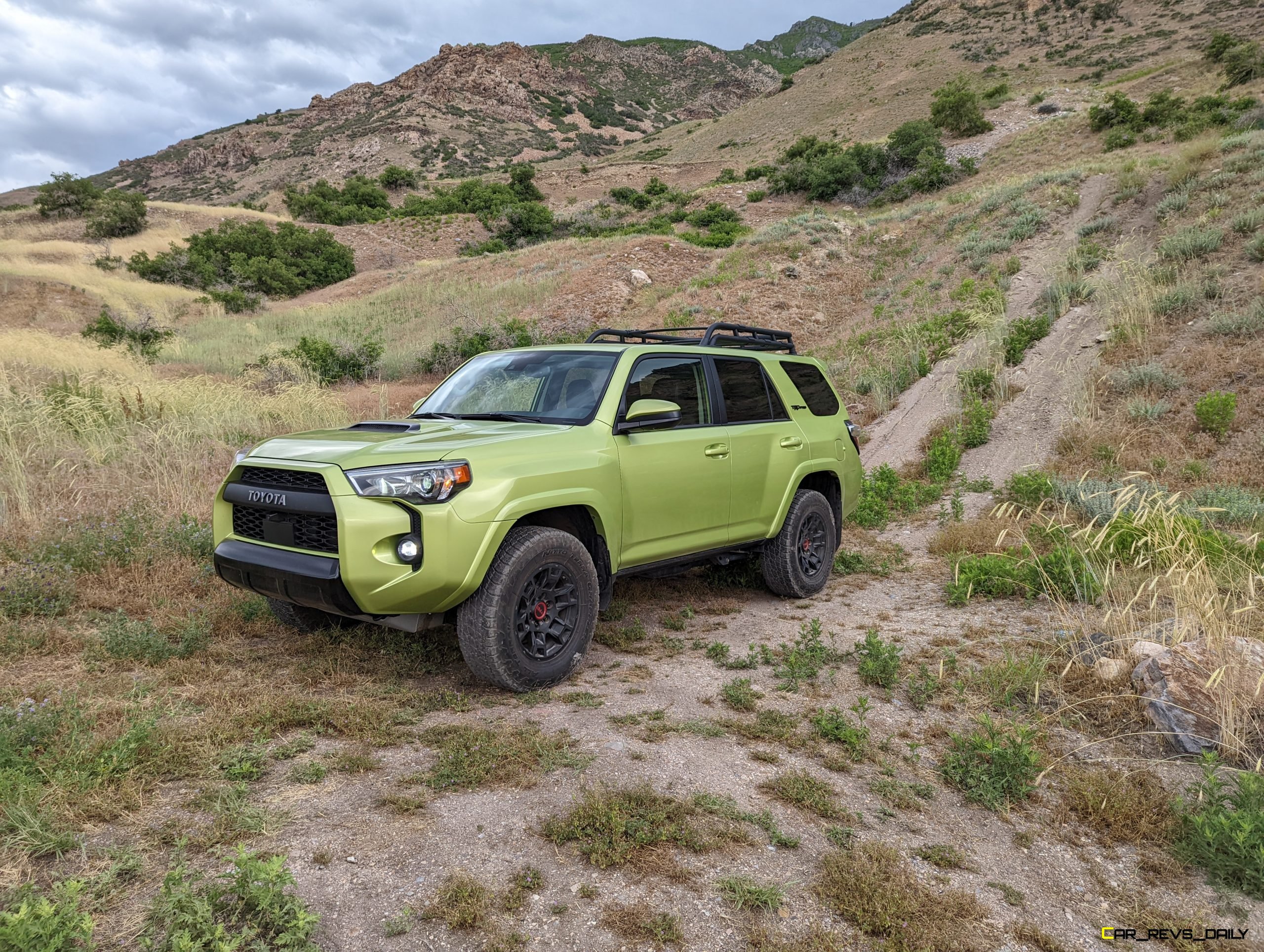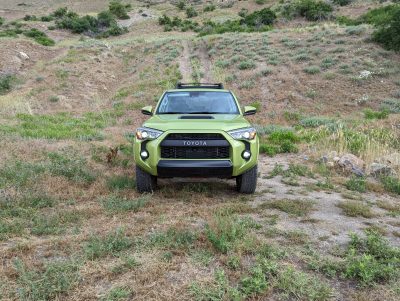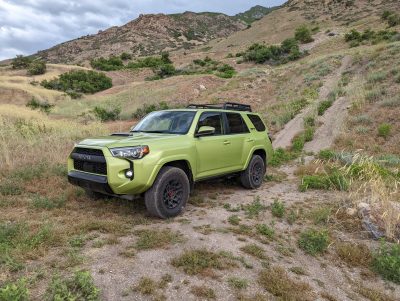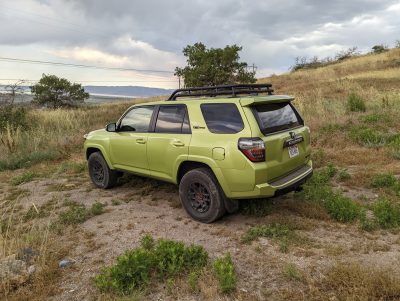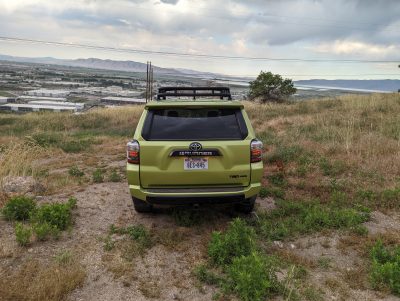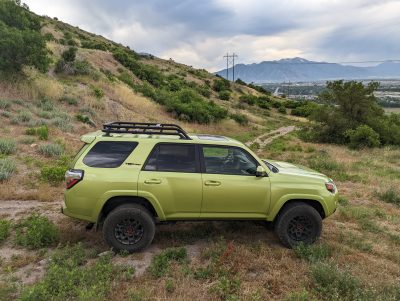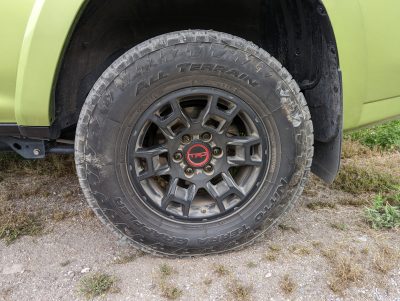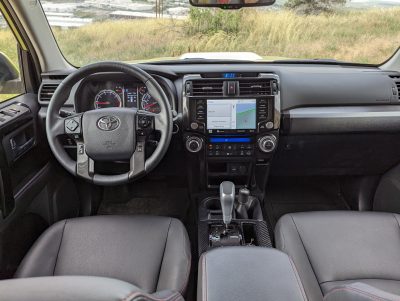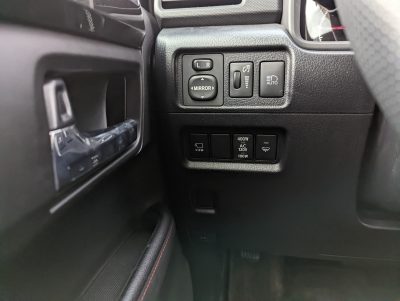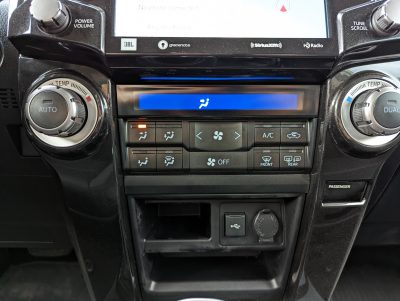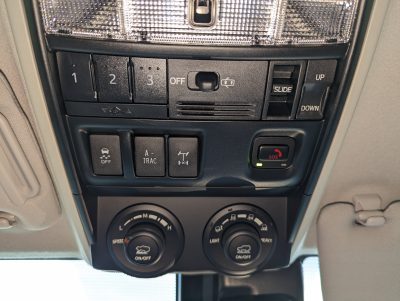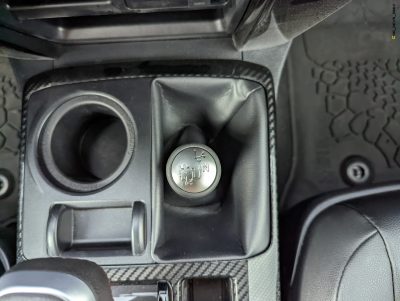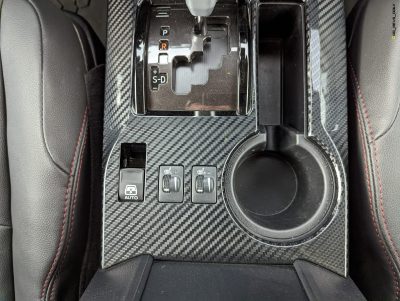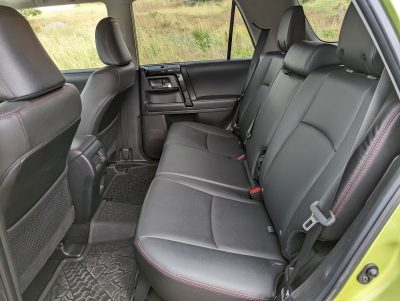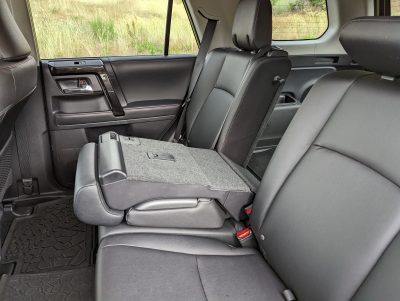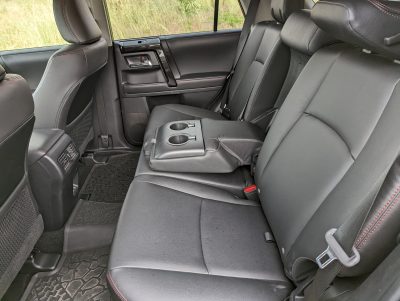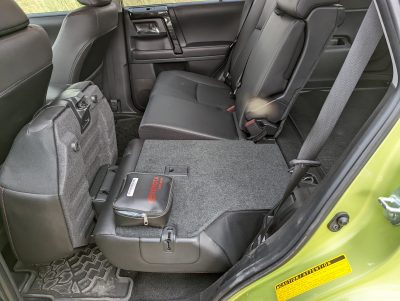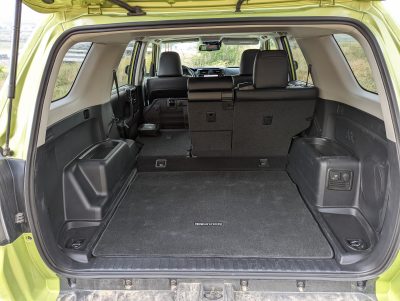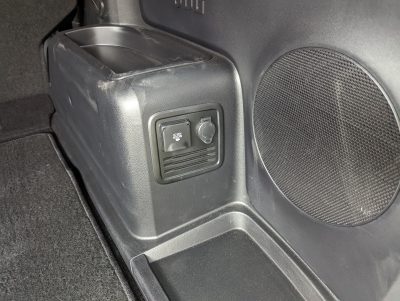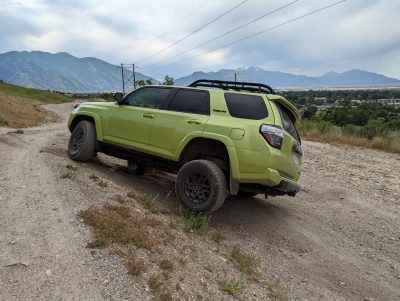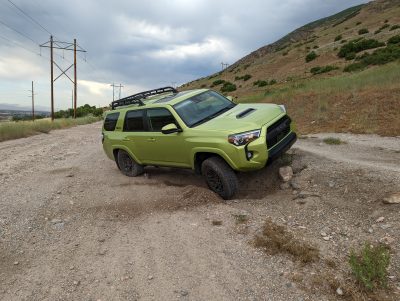Last time Toyota did a major update to the 4Runner was in 2010. Despite the Tacoma getting a new engine in 2016, the 4Runner keeps the venerable 4.0-liter V6. There is a reason for this that we will cover later.
Overview
Outside the 2022 4Runner TRD Pro
Rather than focus on the over a decade old design, let’s talk about the unique features of the TRD Pro. For starters the 2022 4Runner TRD Pro comes with all the features that are on the TRD Off-Road Trim. In addition, the TRD Pro adds a TRD roof rack up top, ¼” thick TRD aluminum front skid plate, 17” matte black flow-formed TRD alloy wheels wrapped in 31.5” Nitto Terra Grappler ATs, and of course the 2.5-inch Fox internal bypass shocks front and rear.
These features do make the 4Runner look a bit more aggressive and capable. The front end is still adorned with a faux hood scoop and faux brake cooling vents in the bumper. Despite their uselessness, these features are attractive and help make the Lime Rush paint pop.
2022 4Runner TRD Pro Interior
Inside, the TRD Pro keeps the SofTex heated front seats and most other features of the TRD Off-Road Premium package. Where it differs is that it comes standard with the Premium JBL Audio system, powered moonroof, TRD Pro shift knob, and TRD Pro floor mats.
While Toyota has upgraded some features on the 2022 4Runner they have left many things in the past. One of the biggest issues is the camera system. Having a high definition screen with a very low quality camera setup makes the camera seem even worse than it is. The cameras are ok for seeing large objects, however for trail use it makes it very hard to see obstacles.
Apart from that the 2022 4Runner TRD Pro has all the features we want, without the fluff of gimmicks we don’t need. The leather seats are stitched in red and are heated up front. The rear seats are comfortable with a fold down center armrest.
Driving
2022 4Runner TRD Pro On-Road
Powered by a 4.0 liter V6 with 270 horsepower and 278 lb-ft of torque running through a 5-speed automatic transmission, the 4Runner is on the slower end of SUVs we’ve tested. However, it has no problem cruising at highway speeds, something we can’t say for the Tacoma. The strength here is partially in the 5-speed auto and partially in the engine design and tuning. Having more gears in a transmission that is tuned to maximize efficiency will keep the RPMs lower at freeway speeds. The downside to this is a significant reduction in torque output because of the lower RPM. Where the 5-speed is beneficial is that the gearing keeps the engine at a decent RPM where it can produce enough torque to keep a consistent speed, even over small inclines like overpasses.
Around town the off-road tuned suspension eats up bumps and potholes without any stress. On the other hand, that same suspension does allow for a lot of brake dive and body lean when cornering or braking hard. The 4Runner is easy to drive and park in crowded cities without being too small to be useful for most household tasks.
Hitting the Dirt, Where it Belongs
Leaving the pavement behind, the 2022 4Runner TRD Pro really shines. Over our high speed course the large Fox dampers and softer suspension simply absorb all but the largest bumps and dips. Compared to other vehicles in this class, the 4Runner TRD Pro has been the smoothest we’ve tested over this course.
On the articulation hill the rear solid axle shows significant travel, while the front independent suspension is much less so. In our testing this won’t matter too much, but for those in consistent hard off-road situations more travel up front would be helpful.
Tackling our toughest challenge, the steep hill climb, was a simple task for the 2022 4Runner TRD Pro. Toyota offers everything from almost no assistance to having the computer take care of everything but steering and stopping. Putting the 4Runner into 4wd low and locking the rear differential made the climb a cake walk. Using Crawl Control also made the climb a simple task.
For those who are new to off-roading the 4Runner can be an excellent option. Putting it in 4wd low will all but eliminate the computer aids. This is where a new driver can learn how to pick a line and develop better skills. If the SUV ends up in a more precarious situation, Multi-Terrain Select, Crawl Control and the rear locker are there to help out.
We were able to do some bonus testing with the 4Runner this time on a rocky mountain trail alongside a Wrangler Rubicon 4xe. It was clear in the first section of the trail that the extra ground clearance of the Rubicon made things much easier than driving the same lines in the 4Runner. However, the shorter wheelbase on the 4Runner actually helped it with maneuverability and reduced the belly scraping.
Conclusion
In conclusion the 2022 4Runner TRD Pro is a very capable off-pavement vehicle. It can handle higher speeds for extended travel over dirt and gravel roads and is very competent when the going gets rough. With great protection underneath and the very capable crawl control, the limits of this vehicle are hard to test without getting into situations that will cause body damage.
At over a decade old, the 2022 4Runner definitely feels its age in many ways. It also exudes a sense of reliability and durability not felt in most other vehicles available today.
Depending on how you classify the 4Runner there really aren’t many competitors in this class. The Jeep Grand Cherokee has similar capability, except for extended high speed travel, but is more luxurious and not as easy to modify. Jeep’s Wrangler is a much more dedicated rock crawler, the Explorer is street oriented, and that leaves the Bronco as probably the closest competitor to the 4Runner.
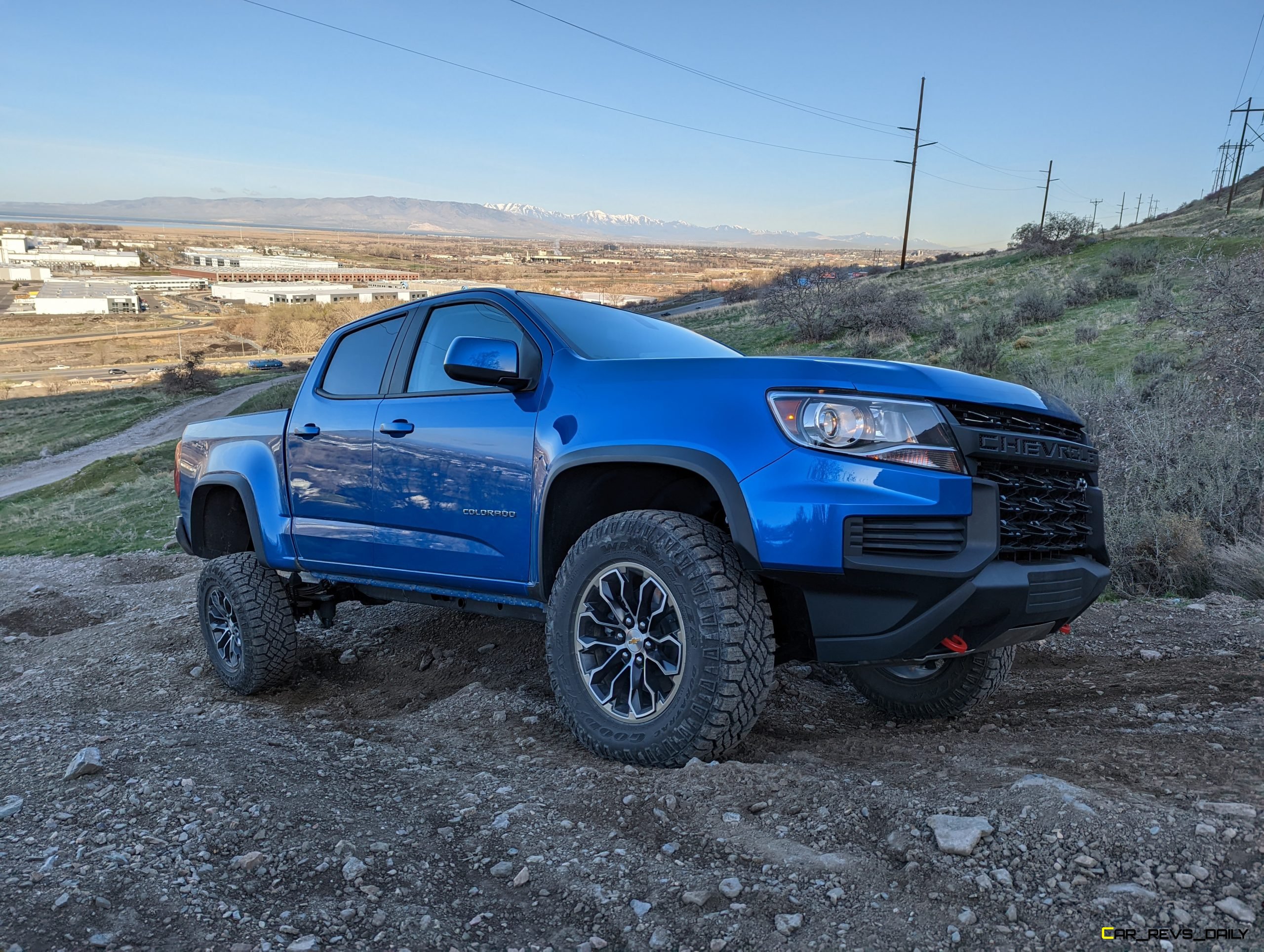
Matthew Barnes is an experienced towing expert. He works as a mechanical engineer and his day job involves testing a variety of vehicles while towing trailers of all types and sizes. Matt shares his knowledge by writing for automotive news outlets in the evenings. When he’s not working he can be found spending time in the great outdoors with his family. He enjoys camping, hiking, canyoneering, and backpacking. Whenever possible he spends time riding in or on any power sports vehicle he can find and claims he can drive anything with a motor, which probably isn’t true.
Matt lives in the Utah mountains and often posts cool off-roading videos to his Instagram and YouTube channel.

